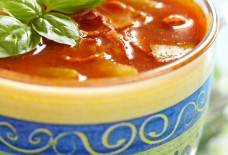Mazzas - Gourmet Delights To Begin A Meal
By Habeeb Salloum/Contributing Writer
An enormous variety of mazza (appetizers), from plain foods to sophisticated dishes are served in the homes or public eating places throughout Middle East and in many Middle Eastern restaurants in the Western world. At times, people forgo the meal after nibbling on these appetizers, which may range from a few dishes to perhaps, as many as a hundred. Visitors who become accustomed to mazza usually when they return home, always include them when planning their invitations for grand meals.
One of the pillars of Middle Eastern cuisine, they reach their epitome in the Greater Syria area, especially Lebanon. A foreshadowing of the delights to come in the meal, mazza are served in small dishes, the number of which usually reflects the generosity of the host and the importance of the meal to follow. Dinner invitation to friends and colleagues always begins with this age-old practice. Millennia of civilized living in the Middle East have established that this is a delightful way to begin a meal – a relaxed method of dining – conducive to socializing, but also to over-eating.
The wide-variety of these appetizers ranges from basic simple dishes to those much more complex. Served in restaurants and homes, mazza entice unsuspecting visitors into eating too much before the main course is served. After sampling a dozen or more mazza dishes, guests may find that they are unable to eat the main course.
I was introduced to mazza during my first trip to Lebanon in the early 1960s when, on the second day of our arrival, we were invited by a friend for a meal in the town of Zahlah – noted for its fine restaurants serving the best in Arab foods. After we sat down to eat, the waiters brought out dish after dish of mazza. Not being familiar with how a meal was served in that food-loving town, I partook of every tasty appetizer, even though warned by my friend that the main course was yet to come.
After I could barely push down another morsel, indeed, the main course did come – barbecued meat galore. The aroma was divine, but alas, I was so sated that I hardly took a bite. It was my first lesson of how one should only nibble in order to enjoy mazza. Unlike as what happened with the invitation of my friend, the Arab code of hospitality forbids warning guests not to partake too much of the appetizers – in fact, a host or hostess will urge their visitors to eat on.
However, even experienced visitors will have trouble confining themselves to a reasonable number of appetizers. The mazza dishes seem to have their own way of ensnaring especially guests who love fine food.
There is nothing more enjoyable then sitting around a table covered by plates of mazza, while guests nibble on whatever food they fancy as they chat between the delightful mouthfuls. The mazza course of the meal can continue for hours and is, without doubt, an excellent way to appreciate the company of one’s guests.
In public places it is the same. No one enjoying their drinks in bars or dining in cafes and restaurants will sip their drink or eat the main course of the meal in a lonely fashion – a whole variety of these appetizers are always there. Dining in dozens of public places in Syria, Lebanon, Palestine and Jordan, I never once had a drink or was served the main meal without the accompaniment of mazza. Rarely was there an eating or drinking outlet that did not serve from a handful to dozens of these mouth-watering tidbits. To sit and just nurse a lonely drink is un-thought of in these ancient lands.
The Arabs were likely the first to establish in the Iberian Peninsula the idea of serving tidbits of food before a meal during the 900 years they were in that part of Europe. The Spanish tradition of gathering before a meal for a drink, while sampling endless appetizers, called tapas, is a replica of the Arab tradition in the Middle East. To a large extent this pleasant and elaborate tradition of serving appetizers is found to be only practiced on a wide scale in the Middle East and Spain.
Once in Cordoba, a Spanish friend invited me to dinner in one of that city’s fine restaurants. As we enjoyed dish after dish of succulent tapas, I remarked to my friend “It’s as if we are dining in one of the Syrian/Lebanese resorts. Tapas are like the mazzas of the Middle East. He smiled “Aren’t we the same people? Many of our ancestors came from that part of the world.”
Endless plates of mazza are the focal point of the Middle Eastern party. People in that part of the world believe that it is a very civilized way of dining. A super mazza table always includes: cheese; meat, spinach and thyme pies; kubba – a meat and burghul dish – both cooked and raw – called the king of Arab Middle Eastern foods; stuffed vegetables of all kinds; fried liver; sliced boiled tongue; fried sausages; and other meat dishes.
On the other hand, for those who are vegetarians, the table also usually includes the simple dishes of pickled black olives, feta and other cheeses, labna – drained yogurt sprinkled with dried mint and olive oil, spiced sliced tomatoes, fresh broad beans, assorted pickles and diced boiled potatoes with an olive oil and lemon juice sauce, as well as the pillars of mazza: baba ghannuj (eggplant purée), hummus bi tahini (chickpea purée) and taboula (parsley and bulgur salad).
However, one need not travel to the Middle East to enjoy a table of mazza. Many urban centres in North America have Arab restaurants and other quick-stop eating places where mazza is available. Perhaps not in quality as found in the Middle East, but enough to whet a diner’s appetite.
Habeeb Salloum







